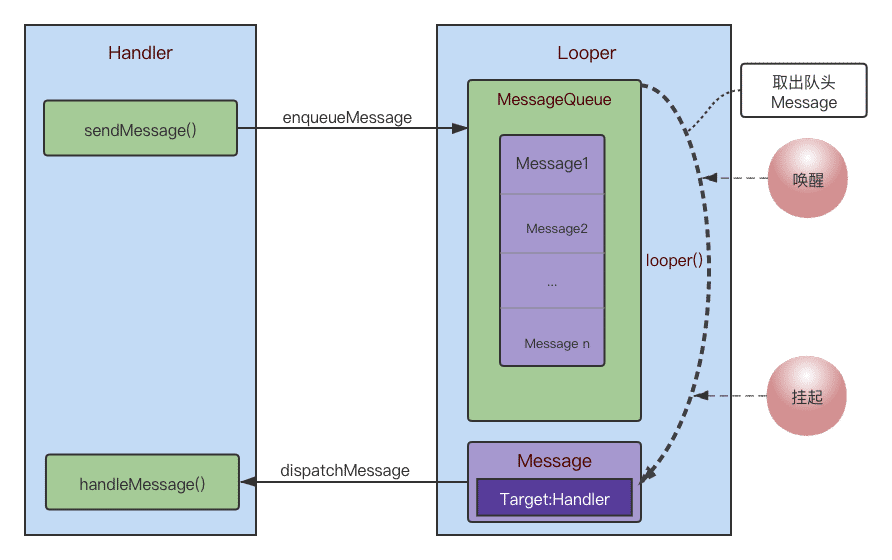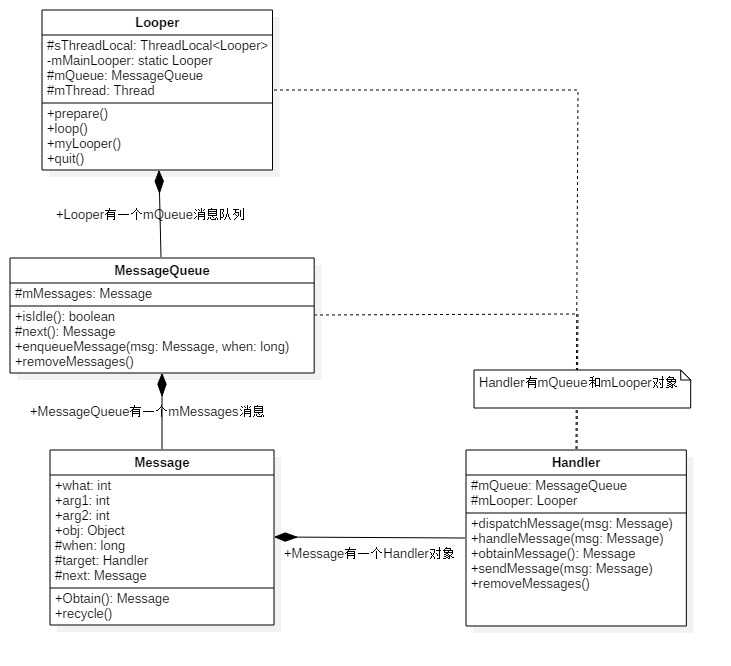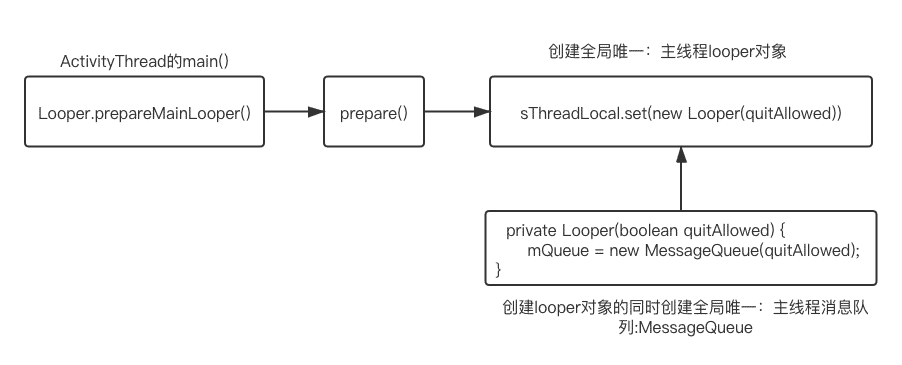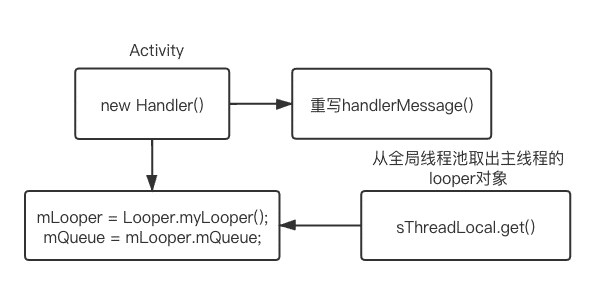1 概述
Android的消息机制简单来说指的是Handler与MessageQueue、Message和Looper完成一个体系机制,它的使用很简单,Handler消息机制用于同进程的线程间通信。通过它可以轻松的将一个任务切换到Handler所在的线程去执行,我们用的最多的地方也就是Handler刷新UI的功能,其实,它还有很多用途,比如子线程中进行消耗的I/O操作,读取文件等,而我们用它来刷新UI,是因为子线程无法刷新UI,可以通过它来切换回主线程执行,因此,本质来说,它只是常用来刷新UI而已。
2 消息机制
先放张消息机制的原理简图:

- Message:消息分为硬件产生的消息(如按钮、触摸)和软件生成的消息;
- MessageQueue:消息队列的主要功能向消息池投递消息(
MessageQueue.enqueueMessage)和取走消息池的消息(MessageQueue.next); - Handler:消息辅助类,主要功能向消息池发送各种消息事件(
Handler.sendMessage)和处理相应消息事件(Handler.handleMessage); - Looper:不断循环执行(
Looper.loop),按分发机制将消息分发给目标处理者。
再放张handler消息机制的架构图

- Looper有一个MessageQueue消息队列;
- MessageQueue有一组待处理的Message;
- Message中有一个用于处理消息的Handler;
- Handler中有Looper和MessageQueue。
由上篇关于Handler的两个问题可知,启动app时ActivityThread会调用Looper.preare()方法,将主线程的looper对象存入ThreadLocal对象中,因此在主线程可以直接通过new Handler()的方式创建handler对象。我们简单对上图的消息机制进行梳理下。
- handler调用sendMessage()方法,会调用enqueueMessage()往消息队列MessageQueue存入消息
- looper对象中有个loop()方法,该方法会轮询根据消息策略,如是否延时发送等,从消息队列中取出消息
- 消息Message对象根据先进先出规则,由消息队列的next()方法实现取出
- 最终调用线程的handler对象的dispatchMessage()方法,最终会回到handler的handlerMessage()方法实现最终的消息消费。
下面根据源码来详细分析handler消息机制的原理。
3 消息机制源码分析
分析handler消息机制抓住两个主要方向就比较好把握了:发送消息和消费消息。首先在activity的子线程创建一个handler。
首先分析主线程创建looper对象的流程。
3.1 主线程创建looper对象
首先看下流程图

[->frameworks//base/core/java/android/app/ActivityThread.java]
public static void main(String[] args) {
...
Looper.prepareMainLooper();
...
}
app启动时调用ActivityThread.java的main()方法,然后调用Looper的prepareMainLooper()。
[->frameworks//base/core/java/android/os/Looper.java]
public static void prepareMainLooper() {
prepare(false);
synchronized (Looper.class) {
if (sMainLooper != null) {
throw new IllegalStateException("The main Looper has already been prepared.");
}
sMainLooper = myLooper();
}
}
private static void prepare(boolean quitAllowed) {
if (sThreadLocal.get() != null) {
throw new RuntimeException("Only one Looper may be created per thread");
}
sThreadLocal.set(new Looper(quitAllowed));
}
prepare()方法可知,app第一次创建的时候,会将主线程作为key,looper对象作为value,存入ThreadLocal对象中。接下来看下初始化Looper()对象的代码。
private Looper(boolean quitAllowed) {
mQueue = new MessageQueue(quitAllowed);
mThread = Thread.currentThread();
}
Looper对象初始化创建了一个消息队列MessageQueue,由于mQueue是Looper的全局变量,因此该消息队列和looper是绑定的。上面的Looper构造函数是private的,因此不能在其他类中通过new Looper()的方式来创建Looper对象,只能通过prepare()方法创建Looper对象。
3.2 主线程创建Handler对象

首先在Activity中重写了Handler的handleMessage()方法。
private Handler mHandler = new Handler() {
@Override
public void handleMessage(@NonNull Message msg) {
super.handleMessage(msg);
handler.sendEmptyMessage(1);
}
};
new Handler()做了什么事情呢?源码走起。
public Handler() {
this(null, false);
}
public Handler(@Nullable Callback callback, boolean async) {
...
mLooper = Looper.myLooper();
...
mQueue = mLooper.mQueue;
...
}
public static @Nullable Looper myLooper() {
return sThreadLocal.get();
}
Looper对象是从sThreadLocal取的,在app启动的时候在ActivityThread的main()调用prepare()存入了主线程的looper了,因此主线程直接创建Handler对象是能够拿到Looper对象的。接下来重点分析handler如何发消息和接收消息的。
3.3 Handler发送消息
发送消息可以用handler的sendEmptyMessage、sendMessage、sendEmptyMessageDelayed、sendEmptyMessageAtTime、sendMessageAtTime。这几个方法最终都会调用Handler的enqueueMessage()方法将消息存入消息队列中。
private boolean enqueueMessage(@NonNull MessageQueue queue, @NonNull Message msg,
long uptimeMillis) {
msg.target = this;
msg.workSourceUid = ThreadLocalWorkSource.getUid();
if (mAsynchronous) {
msg.setAsynchronous(true);
}
return queue.enqueueMessage(msg, uptimeMillis);
}
enqueueMessage()最终调用MessageQueue的enqueueMessage()方法将消息压入消息队列MessageQueue中。消息队列是一种先进先出的数据结构。
boolean enqueueMessage(Message msg, long when) {
// 每一个普通Message必须有一个target
if (msg.target == null) {
throw new IllegalArgumentException("Message must have a target.");
}
if (msg.isInUse()) {
throw new IllegalStateException(msg + " This message is already in use.");
}
synchronized (this) {
if (mQuitting) {//正在退出时,回收msg,加入到消息池
IllegalStateException e = new IllegalStateException(
msg.target + " sending message to a Handler on a dead thread");
Log.w(TAG, e.getMessage(), e);
msg.recycle();
return false;
}
msg.markInUse();
msg.when = when;
Message p = mMessages;
boolean needWake;
if (p == null || when == 0 || when < p.when) {
//p为null(代表MessageQueue没有消息) 或者msg的触发时间是队列中最早的, 则进入该该分支
// New head, wake up the event queue if blocked.
msg.next = p;
mMessages = msg;
needWake = mBlocked;//当阻塞时需要唤醒
} else {
// Inserted within the middle of the queue. Usually we don't have to wake
// up the event queue unless there is a barrier at the head of the queue
// and the message is the earliest asynchronous message in the queue.
//将消息按时间顺序插入到MessageQueue。一般地,不需要唤醒事件队列,除非
//消息队头存在barrier,并且同时Message是队列中最早的异步消息。
needWake = mBlocked && p.target == null && msg.isAsynchronous();
Message prev;
//将新来的msg消息插入到消息队列尾部
for (;;) {
prev = p;
p = p.next;
if (p == null || when < p.when) {
break;
}
if (needWake && p.isAsynchronous()) {
needWake = false;
}
}
msg.next = p; // invariant: p == prev.next
prev.next = msg;
}
...
}
MessageQueue是按照Message触发时间的先后顺序排列的,队头的消息是将要最早触发的消息。当有消息需要加入消息队列时,会从队列头开始遍历,直到找到消息应该插入的合适位置,以保证所有消息的时间顺序。
3.4 Handler消费消息

在app启动时在ActivityThread的main()方法中启动了Looper.loop()方法,下面重点分析loop()方法。
public static void loop() {
//获取Looper对象
final Looper me = myLooper();
if (me == null) {
throw new RuntimeException("No Looper; Looper.prepare() wasn't called on this thread.");
}
//获取消息队列对象
final MessageQueue queue = me.mQueue;
// Make sure the identity of this thread is that of the local process,
// and keep track of what that identity token actually is.
Binder.clearCallingIdentity();
//确保在权限检查时基于本地进程,而不是调用进程。
final long ident = Binder.clearCallingIdentity();
//进入loop的主循环方法
for (;;) {
//等待消息,可能会堵塞,底层采用linux的进程间机制,因此没消息主线程就休眠,有消息就唤醒,因此
//死循环也不会产生ANR
Message msg = queue.next(); // might block
//没有消息,则退出循环
if (msg == null) {
// No message indicates that the message queue is quitting.
return;
}
...
try {
//用于分发Message
msg.target.dispatchMessage(msg);
...
//将Message放入消息池
msg.recycleUnchecked();
}
}
loop()进入循环模式,不断重复下面的操作,直到没有消息时退出循环
- 读取MessageQueue的下一条Message;
- 把Message分发给相应的target;
- 再把分发后的Message回收到消息池,以便重复利用。
首先看下MessageQueue读取消息的代码
Message next() {
// Return here if the message loop has already quit and been disposed.
// This can happen if the application tries to restart a looper after quit
// which is not supported.
final long ptr = mPtr;
//当消息循环已经退出,则直接返回
if (ptr == 0) {
return null;
}
// 循环迭代的首次为-1
int pendingIdleHandlerCount = -1; // -1 only during first iteration
int nextPollTimeoutMillis = 0;
for (;;) {
if (nextPollTimeoutMillis != 0) {
Binder.flushPendingCommands();
}
//阻塞操作,当等待nextPollTimeoutMillis时长,或者消息队列被唤醒,都会返回
nativePollOnce(ptr, nextPollTimeoutMillis);
synchronized (this) {
// Try to retrieve the next message. Return if found.
final long now = SystemClock.uptimeMillis();
Message prevMsg = null;
Message msg = mMessages;
//当消息的Handler为空时,则查询异步消息
if (msg != null && msg.target == null) {
// Stalled by a barrier. Find the next asynchronous message in the queue.
//当查询到异步消息,则立刻退出循环
do {
prevMsg = msg;
msg = msg.next;
} while (msg != null && !msg.isAsynchronous());
}
if (msg != null) {
if (now < msg.when) {
// Next message is not ready. Set a timeout to wake up when it is ready.
//当异步消息触发时间大于当前时间,则设置下一次轮询的超时时长
nextPollTimeoutMillis = (int) Math.min(msg.when - now, Integer.MAX_VALUE)
} else {
// Got a message.
// 获取一条消息,并返回
mBlocked = false;
if (prevMsg != null) {
prevMsg.next = msg.next;
} else {
mMessages = msg.next;
}
msg.next = null;
if (DEBUG) Log.v(TAG, "Returning message: " + msg);
//设置消息的使用状态,即flags |= FLAG_IN_USE
msg.markInUse();
//成功地获取MessageQueue中的下一条即将要执行的消息
return msg;
}
} else {
// No more messages.
//没有消息
nextPollTimeoutMillis = -1;
}
// Process the quit message now that all pending messages have been handled.
//消息正在退出,返回null
if (mQuitting) {
dispose();
return null;
}
// If first time idle, then get the number of idlers to run.
// Idle handles only run if the queue is empty or if the first message
// in the queue (possibly a barrier) is due to be handled in the future.
//当消息队列为空,或者是消息队列的第一个消息时
if (pendingIdleHandlerCount < 0
&& (mMessages == null || now < mMessages.when)) {
pendingIdleHandlerCount = mIdleHandlers.size();
}
if (pendingIdleHandlerCount <= 0) {
// No idle handlers to run. Loop and wait some more.
//没有idle handlers 需要运行,则循环并等待。
mBlocked = true;
continue;
}
if (mPendingIdleHandlers == null) {
mPendingIdleHandlers = new IdleHandler[Math.max(pendingIdleHandlerCount, 4)];
}
mPendingIdleHandlers = mIdleHandlers.toArray(mPendingIdleHandlers);
}
// Run the idle handlers.
// We only ever reach this code block during the first iteration.
//只有第一次循环时,会运行idle handlers,执行完成后,重置pendingIdleHandlerCount为0.
for (int i = 0; i < pendingIdleHandlerCount; i++) {
final IdleHandler idler = mPendingIdleHandlers[i];
mPendingIdleHandlers[i] = null; // release the reference to the handler
boolean keep = false;
try {
//idle时执行的方法
keep = idler.queueIdle();
} catch (Throwable t) {
Log.wtf(TAG, "IdleHandler threw exception", t);
}
if (!keep) {
synchronized (this) {
mIdleHandlers.remove(idler);
}
}
}
// Reset the idle handler count to 0 so we do not run them again.
//重置idle handler个数为0,以保证不会再次重复运行
pendingIdleHandlerCount = 0;
// While calling an idle handler, a new message could have been delivered
// so go back and look again for a pending message without waiting.
//当调用一个空闲handler时,一个新message能够被分发,因此无需等待可以直接查询pending message
nextPollTimeoutMillis = 0;
}
}
nativePollOnce是阻塞操作,其中nextPollTimeoutMillis代表下一个消息到来前,还需要等待的时长;当nextPollTimeoutMillis = -1时,表示消息队列中无消息,会一直等待下去。
当处于空闲时,往往会执行IdleHandler中的方法。当nativePollOnce()返回后,next()从mMessages中提取一个消息。
接下来分析消息分到到activity的handler处理。
public void dispatchMessage(@NonNull Message msg) {
if (msg.callback != null) {
//当Message存在回调方法,回调msg.callback.run()方法;
handleCallback(msg);
} else {
if (mCallback != null) {
//当Handler存在Callback成员变量时,回调方法handleMessage();
if (mCallback.handleMessage(msg)) {
return;
}
}
//Handler自身的回调方法handleMessage()
handleMessage(msg);
}
}
分发消息流程:
- 当
Message的回调方法不为空时,则回调方法msg.callback.run(),其中callBack数据类型为Runnable,否则进入步骤2; - 当
Handler的mCallback成员变量不为空时,则回调方法mCallback.handleMessage(msg),否则进入步骤3; - 调用
Handler自身的回调方法handleMessage(),该方法默认为空,Handler子类通过覆写该方法来完成具体的逻辑。
对于很多情况下,消息分发后的处理方法是第3种情况,即Handler.handleMessage(),一般地往往通过覆写该方法从而实现自己的业务逻辑。
4 总结
再次看下消息机制的原理简图

- Handler通过sendMessage()等方法发送Message到MessageQueue队列;
- Looper通过loop(),不断提取出达到触发条件的Message,并将Message交给target(即handler)来处理;
- 经过dispatchMessage()后,交回给Handler的handleMessage()来进行相应地处理。
- 将Message加入MessageQueue时,处往管道写入字符,可以会唤醒loop线程;如果MessageQueue中没有Message,并处于Idle状态,则会执行IdelHandler接口中的方法,往往用于做一些清理性地工作。